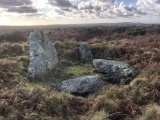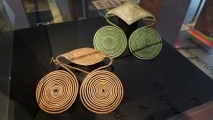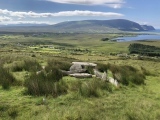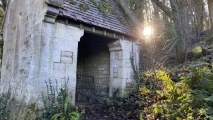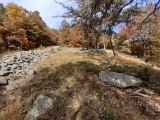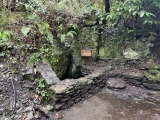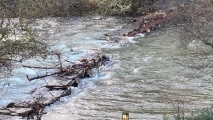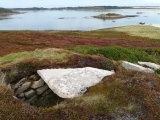Andy Burnham's Blog, page 117
January 21, 2023
Sperris Quoit
This quoit is quite badly ruined with only one upright and three fallen stones remaining. The chamber tends to get flooded with water. With amazing rock formations and a possible logan stone on the nearby hill. Access can be hard work through dense gorse and narrow paths. Wear good trousers!
Published on January 21, 2023 09:24
January 19, 2023
Helms Museum Harburg
Top Photo: Bronze Age hair knot jewellery. Helms Museum in Harburg, near Hamburg has a permanent exhibition of prehistoric objects. Lots more photos on our page
Published on January 19, 2023 05:56
January 18, 2023
Keel East court tomb
This court tomb sits on the lower slopes of Slievemore, Co. Mayo. It offers an amazing view south of the cliffs of Minaun and the Atlantic churning beneath. The tomb itself is aligned North-South, drawing the eye to the distant cliffs. looking north, the court opens to face the peak of Slievemore. A signposted path leads up to the tomb from the road. The tomb's court and rear chamber are fairly intact. Collapse and robbing of material have made it difficult to determine whether there were originally two or maybe three chambers. The roof stone of the rear chamber is impressively large and very flat on top. A possible lintel stone to the passage lies in the court where the entrance would have been.
Published on January 18, 2023 07:44
January 17, 2023
Cliff Well
A new video from Tim linked from our page. An impressive Victorian well house situated over a now capped well, situated right upon the Cotswold Way trail.
The south-east external side has a trough, the north west facing side is open. Old graffiti and carvings can be seen. A new, waxing moon with "Cave Adest Nox" (Take Care that The Night is Here), and a sunburst with "Instat Dies Transiit Nox" (The Day Passed into Night).
The south-east external side has a trough, the north west facing side is open. Old graffiti and carvings can be seen. A new, waxing moon with "Cave Adest Nox" (Take Care that The Night is Here), and a sunburst with "Instat Dies Transiit Nox" (The Day Passed into Night).
Published on January 17, 2023 05:03
January 15, 2023
Fort Mountain Stone Enclosure
Prehistoric drystone wall site in Georgia, USA. This ancient 285m (930 ft) stone wall is thought to have been built by Woodland-era Native Americans between 500 BCE and 500 CE. Note the serpent-like deep bend in the wall in the top photo. The layout does not appear to support the wall having been an actual defensive fortification, as its many zigzags would not support any concealment of defenders in multiple locations and do not take advantage of natural contours.
Published on January 15, 2023 07:32
Quarteira 6000 years
A temporary exhibition of 6000 years of history on Quarteira set up in a one floor building next to the harbour. It gives a clear timeline with information on the history of this Portuguese fishermens' village, including geographical information about the coastline, the changing of the sea level and the inhabitants. In the area many archaeological artefacts have been found, such as a quartzite scraper of the 5th to the 3rd millennium BC, tools from the Neolithic period of 6000 years ago. A lot of additional information can be found digitally on touch screens.
Published on January 15, 2023 04:10
January 14, 2023
Ffynnon Cyngar Sant / St Cyngars Well
Ffynnon Cyngar Sant / St Cyngars Well lies in The Dingle (Nant y Pandy), which is by the church of St Cyngar in the town of Llangefni, Anglesey. The well was restored in 2000 by the Women's Institute (Merched y Waur) and was formally known as Ffynnon y Plâs. It was reputedly named after a local house, Plâs from the 1500s which was demolished in the 1940s.
Published on January 14, 2023 15:25
January 13, 2023
Tarr Steps Prehistoric Bridge
The ancient Tarr Steps clapper bridge on Exmoor, said to be 'built by the devil' and possibly dating back to 1000BC, has again been partially washed away. . A (possibly) prehistoric bridge over the river Barle near Winsford. It is certainly Medieval and a much older date back to 1000 BC or beyond seems entirely possible. Some of the stones weigh 5 tons and were said to have been placed there by the Devil to win a bet.
Published on January 13, 2023 10:38
January 12, 2023
Samson, North Hill
The visible grave on St Samson, Isles of Scilly is perhaps the best example, surrounded by kerbstones and roofed by two capstones. The well-preserved entrance looks in an easterly direction. Excavations in 1930 found no human remains but flints, a possible whetstone, Neolithic pottery and the remains of a saddle quern.
Published on January 12, 2023 08:04
January 11, 2023
Broby Vesterskov Stensætning
Located slightly hidden away from the nearby footpath is an interesting collection of large stones sitting in a circle with a very large boulder within the circle. Archaeologists are unsure what this stone circle really is, but the most common theory is that the stones used in the circle actually come from a now removed megalithic tomb where the large boulder was a capstone that couldn't be removed due to its size - as it is believed the megalithic tomb was destroyed for its stones to be used in construction. The other stones that weren't removed for construction were then placed in a circle around the large boulder which what we see today.
Published on January 11, 2023 05:50

